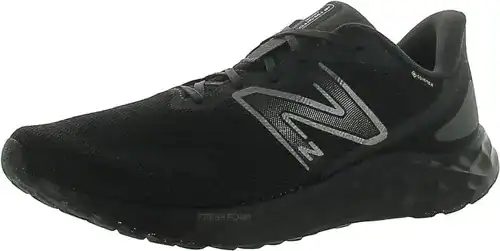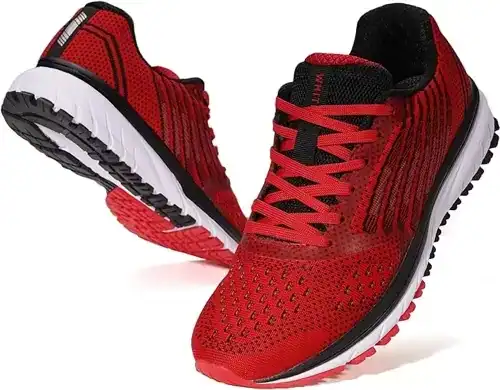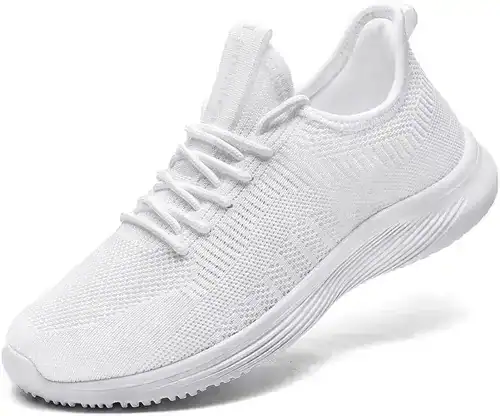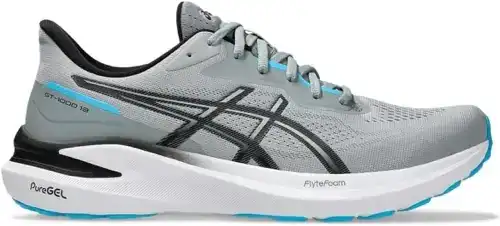Last Updated on September 3, 2025
Looking for the best budget running shoes that don’t compromise on comfort or quality? You’re not alone. Many runners assume that affordable athletic shoes can’t deliver the same performance as high-end models—but that’s not always true. While premium brands often charge $150 or more, we’ve found cheap running shoes in 2025 that are actually good—some for under $50.
How is this possible? These lower-cost models often use time-tested designs, slightly older cushioning tech, or streamlined materials that cut costs without cutting corners. You’ll still find breathable mesh uppers, supportive midsoles, and reliable traction—just without the luxury price tag or flashy marketing.
Whether you’re a beginner, casual jogger, or training on a budget, the following shoes offer impressive value and performance. Our guide highlights affordable picks that feel great, hold up over time, and suit a wide range of running styles.
Shoe Model (click link to scroll to review) | Gender | Best For | Cushioning | Price Range | Price |
|---|---|---|---|---|---|
Overall Value | BioMoGo DNA | Under $90 | |||
Budget & Gym Use | Soft Foam | Under $75 | |||
Sleek Design | Fresh Foam | Under $80 | |||
Comfort & Casual | Cloudfoam | Under $65 | |||
Platform Design | Dense Foam | Under $50 | |||
Lowest Price | Memory Foam | Under $45 | |||
Stability/Support | FF BLAST™ / GEL | Under $95 | |||
Air Cushioning | Zoom Air/Foam | Under $90 |
In-depth Reviews of Budget Running Shoes
Looking for affordable running shoes? These in-depth reviews cover top budget picks under $100, with pros, cons, and specs—plus links to men’s and women’s versions so you can find the perfect fit fast.
Brooks Revel 7
Best for: Overall Value

The Brooks Revel 7 stands out as one of the best value running shoes you can buy. While it doesn’t have the high-end tech of Brooks’ flagship Ghost series, it brings dependable performance and comfort at a more affordable price. You won’t find DNA LOFT v3 or max cushioning here, but what you do get is Brooks’ trusted BioMoGo DNA midsole, which adapts well to everyday running and walking. The updated knit upper looks sleek and provides a comfortable fit that adapts to most foot shapes, while the segmented crash pad helps smooth transitions from heel to toe.
The biggest trade-off at this lower price point is durability for long-distance runners or high-mileage training—this isn’t a marathon shoe. It also lacks premium arch support or medial stability for overpronators. However, if you’re looking for a lightweight, stylish, neutral shoe for daily runs, errands, or gym workouts, the Revel 7 is an excellent buy.
In short, it punches above its price tag in comfort and design without sacrificing key performance features.
Specs
- BioMoGo DNA cushioning
- Breathable knit upper
- Neutral support
- Rubber outsole with good traction
Pros
- Excellent comfort for daily runs
- Lightweight and responsive
- Stylish design for casual wear
- Durable construction for the price
Cons
- Not ideal for high-mileage runners
- Lacks advanced stability features
Men’s version | Women’s version
Nike Revolution 7
Best for: Budget & Gym Use

The Nike Revolution 7 is a well-rounded, entry-level running shoe that combines brand reliability with affordability. Priced under $75, it’s perfect for beginners, walkers, or gym-goers. You won’t find Zoom Air or React foam here, and that’s okay—Nike keeps costs down by using a soft, basic EVA foam midsole and a lightweight knit upper that offers decent breathability. The minimal design makes it versatile for daily wear and fitness routines.
What you’re not getting is long-distance durability or technical features like medial posts or energy return foams. It’s also not built for serious overpronation or intense outdoor mileage. That said, the Revolution 5 is a fantastic shoe for those who need something comfortable, flexible, and stylish for short runs or everyday use.
If you’re on a budget or just easing into a fitness routine, the Revolution 5 won’t disappoint. It’s reliable, looks great, and holds up well in indoor or low-impact environments.
Specs
- Soft foam midsole
- Breathable knit upper
- Neutral arch support
- Minimalist profile
Pros
- Extremely affordable
- Great for short runs or treadmill use
- Stylish enough for daily wear
- Breathable and lightweight
Cons
- Sole durability is limited
- Minimal arch or heel support for longer runs
Men’s version | Women’s version
New Balance Fresh Foam Arishi v4
Best for: Sleek Design

The New Balance Fresh Foam Arishi v4 is a lightweight, stylish, and affordable neutral trainer that’s perfect for casual runners or anyone looking for a great all-day shoe. With Fresh Foam cushioning and an engineered mesh upper, it offers solid comfort for under $80. While you’re not getting the premium Fresh Foam X found in New Balance’s higher-end models like the 1080, this version still delivers a smooth, supportive ride ideal for everyday training, walking, or commuting.
It’s a shoe that balances form and function. You’ll miss out on the added bounce or structured fit that more expensive models offer, but you’ll still enjoy a clean silhouette, dependable cushioning, and a flexible fit. It’s not built for speedwork or marathon training—but if you’re in the market for a do-it-all shoe on a budget, the Arishi v4 fits the bill.
This shoe excels for daily wear, fitness walking, or casual running. It’s stylish enough to wear with jeans or joggers, making it a great budget crossover pick.
Specs
- Fresh Foam midsole
- Engineered mesh upper
- Cushioned yet lightweight ride
- Neutral support
Pros
- Modern, streamlined appearance
- Good arch and heel cushioning
- Excellent for casual runners
- Highly breathable upper
Cons
- Less bounce than performance models
- Upper may not be as supportive as premium shoes
Men’s version | Women’s version
Adidas Cloudfoam Pure / Duramo SL 2
Best for: Comfort & Casual


The Adidas Cloudfoam Pure (for women) and the similar model for men called Adidas Duramo SL 2 are excellent low-cost options for people who prioritize step-in comfort, casual wear, and low-impact fitness. These shoes use Adidas’ proprietary Cloudfoam cushioning in both the insole and midsole to create a soft, pillowy feel from the first step. While they’re technically classified as running shoes, they shine more in walking, gym classes, and all-day casual use.
You won’t get the stability or spring of Boost foam, nor the responsive tech of Lightstrike, but for the price (usually under $65), you’ll still enjoy lightweight support, breathable mesh uppers, and a streamlined silhouette. The slip-on style of the women’s version is especially popular for its convenience and modern look.
What’s missing is long-term durability on pavement and trail runs, as the outsole rubber is thin and the upper lacks structural overlays. Still, these shoes are a fantastic crossover option for budget-conscious buyers who want something soft, flexible, and stylish.
Specs
- Cloudfoam midsole and insole
- Sock-like knit fit (Pure)
- Textile upper
- Flexible rubber sole
Pros
- Soft comfort from step-in to finish
- Ideal for walking and errands
- Flexible and lightweight
- Trendy design
Cons
- Less suitable for actual running
- Lower outsole durability
Men’s version | Women’s version
Joomra Supportive Running Shoes
Best for: Platform Design

Joomra’s Supportive Running Shoe is a sleeper hit in the low-budget category—especially for runners who want a more natural foot position. With a low heel-to-toe drop and a level platform design, it promotes a more neutral stride that’s ideal for midfoot or forefoot runners. For a shoe under $50, it delivers surprisingly good support, cushioning, and comfort.
You won’t get brand-name foam tech or elite racing materials here, but Joomra gives you what counts: a high-density foam midsole, a breathable knit upper, and thoughtful features like a padded collar and lace garages to keep everything in place. This makes it an excellent daily trainer or walking shoe for anyone looking to avoid a steep price tag.
The drawbacks? The shoe’s color may fade with use, and there may be some off-gassing smell when first unboxed. But for the price, it’s hard to beat if you’re after a minimal, no-nonsense runner that gets the job done.
Specs
- High-density foam midsole
- Engineered knit upper
- Low heel drop
- Lace garage and padded collar
Pros
- Natural ride feel
- Good cushioning for the price
- Secure fit with lace garage
- Excellent budget value
Cons
- Color can fade quickly
- May off-gas when unboxing
Men’s version | Women’s version
Lamincoa Athletic Running Shoe
Best for: Lowest Price

If you want the absolute lowest price possible for a wearable running shoe, Lamincoa delivers. Often available for under $45, this shoe is a solid choice for casual fitness enthusiasts, walkers, and budget-driven buyers. It’s not packed with elite running technology, but it gets the basics right: a soft memory foam insole, a breathable knit upper, and a flexible slip-on design that’s easy to wear and lightweight.
Where it cuts corners is ankle support and overall durability—this isn’t a shoe for running marathons or harsh pavement. But it’s great for daily walking, errands, travel, or general activity. The anti-collision toe cap and anti-slip outsole add small but welcome features for a shoe in this price range.
The fit is forgiving, and its slip-on style appeals to people who want fuss-free footwear. If you’re okay with moderate performance and want something comfortable, it’s one of the best-value options available.
Specs
- Memory foam insert
- Breathable mesh upper
- Slip-on streamlined design
- Anti-collision toe cap
Pros
- Incredibly affordable
- Cushioned for light walking and errands
- Flexible and lightweight
- Quick and easy to put on
Cons
- Limited ankle support
- Not built for long-distance running
Men’s version | Women’s version
ASICS GT-1000 13
Best for: Moderate Stability

The ASICS GT-1000 13 delivers dependable light stability and solid cushioning at a lower price than most structured running shoes. As the latest version in ASICS’ GT series, it retains the trusted LITETRUSS stability system for mild overpronation correction while improving breathability, weight, and responsiveness. At under $90, it’s a budget-friendly option for runners or walkers needing gentle arch support without sacrificing comfort.
You won’t get max-cushioning like in ASICS Kayano, or the premium feel of the GEL-Nimbus, but the GT-1000 13 offers excellent midsole rebound from FLYTEFOAM and a snug, engineered mesh upper that adapts well to different foot shapes. The OrthoLite X-30 sockliner adds a soft step-in feel, and the AHAR rubber outsole gives good traction and durability for daily mileage.
This shoe is best for moderate runners, fitness walkers, and anyone who wants a well-rounded support shoe under $100. The GT-1000 13 continues to be a reliable choice for value-conscious shoppers who don’t want to compromise on stability or performance.
Specs
- Weight: 8.4 oz (238 g) women | 9.9 oz (281 g) men
- Sizes: Men’s 7–15 | Women’s 5–13
- Widths: Regular (D men / B women), Wide (2E men / D women)
- FLYTEFOAM midsole
- LITETRUSS support system
- Engineered mesh upper
- OrthoLite X-30 sockliner
- AHAR rubber outsole
Pros
- Great value for a support shoe
- Light, responsive feel
- Breathable and comfortable fit
- Durable outsole
Cons
- Not built for maximum speed or distance
- Less cushion than premium models
Men’s version | Women’s version
Nike Winflo 11
Best for: Neutral Cushioning

The Nike Winflo 11 delivers surprisingly premium comfort and styling for an $80 price tag, making it one of the best-value neutral running shoes in Nike’s lineup. This version refines the formula with an improved upper fit, slightly softer ride, and sleek design that transitions easily from workouts to everyday wear.
Powered by a Cushlon foam midsole and a full-length Nike Air unit, the Winflo 11 offers smooth cushioning and responsive support without feeling bulky. It’s ideal for daily runs, treadmill sessions, or long walks, especially for newer runners or those with a neutral stride. The redesigned engineered mesh upper improves breathability and step-in comfort, while the updated heel clip adds stability without sacrificing flexibility.
What you’re not getting is Nike’s elite tech—no ZoomX or React foam, and no carbon plate. But for under $100, the Winflo 11 covers the essentials better than many budget competitors. It’s well-built, lightweight, and available in wide sizes.
Specs
- Weight: 8.6 oz (244 g) women | 10.3 oz (292 g) men
- Sizes: Men’s 6–15 | Women’s 5–12
- Widths: Regular (D men / B women), Wide (2E men / D women)
- Cushlon foam midsole + full-length Nike Air
- Updated engineered mesh upper
- Durable waffle-pattern rubber outsole
Pros
- Soft ride with consistent support
- Stylish design suitable for casual wear
- Available in wide sizes
- Excellent price-to-performance ratio
Cons
- Lacks premium cushioning found in higher-end Nike models
- Not ideal for high-speed or marathon training
Men’s version | Women’s version
Buyer’s Guide: Coach-Level Advice for Choosing Budget-Friendly Running Shoes
Buying cheap running shoes doesn’t mean buying bad ones—but it does mean you need to be smart. As a running coach, I often help athletes with limited budgets choose gear that protects their feet, supports their goals, and keeps them injury-free. This guide is built to help you do just that.
What to Look for in a Budget Running Shoe
Start with the midsole—the heart of any running shoe. The foam used here determines how your shoe absorbs shock and rebounds with each stride. Look for models with EVA blends or proprietary foams like Nike React, New Balance Fresh Foam, or Brooks DNA. These offer enough softness for long runs but don’t turn your foot into mush like generic foam does. Give the forefoot a bend; a good midsole will rebound, not fold. A midsole that compresses and stays flat under pressure signals poor quality.
Breathability and Foot Comfort Matter
Ventilation is essential. During a run, your feet will swell and heat up. Shoes with engineered mesh uppers and strategic perforations help release heat and prevent hotspots and blisters. If you hold the shoe up to the light and can’t see through parts of the upper, it’s likely to trap moisture. Choose options with visible ventilation zones—especially across the forefoot and sides.
Durable Outsole for Long-Term Value
Durability matters too, particularly on the outsole. Flip the shoe over and look for carbon or blown rubber patches on the heel and forefoot. These are high-impact zones, and exposed foam here wears out quickly. If you can press a fingernail into the sole and leave a dent across these areas, the outsole likely won’t last more than a couple hundred miles—especially if you run on pavement.
Match the Shoe to Your Gait Type
Foot structure and gait should guide your choice. Neutral runners will do fine with shoes that have even cushioning and no added arch reinforcements. If you tend to overpronate—where your foot rolls too far inward—you’ll need a stability shoe with firmer foam or a medial post to prevent collapse. Supinators—those whose feet roll outward—should look for flexible shoes with extra lateral support and a cushioned ride. Check the label: shoes are often clearly marked as “neutral,” “stability,” or “motion control.” When in doubt, ask for help or consult online brand guides.
Why Heel-to-Toe Drop Makes a Difference
Consider the heel-to-toe drop. If you’re new to running or land on your heel, a traditional drop of 8–12 mm is safest. It reduces stress on your Achilles and calf. If you’re a midfoot or forefoot striker, you may feel better in a lower drop (4–6 mm) that supports a more natural stride. Changing drop too abruptly can cause injuries, so stick close to what you’re used to unless transitioning slowly.
Red Flags That Signal a Bad Buy
A common mistake is picking a fashion sneaker that only looks like a runner. These shoes often lack structure under the arch and fold easily in the middle. A proper running shoe bends only at the toe box—not in the middle of the sole. Twist the shoe in your hands; it should resist torque, especially at the midfoot.
Beware of uppers made from stiff synthetic materials. Some budget shoes use hard polyurethane that won’t stretch or break in. That leads to pressure points and friction. If the upper feels stiff out of the box, it will likely stay that way. Engineered mesh and knit fabrics are more forgiving and breathable.
Weight is another giveaway. Heavier shoes often contain older, denser foam or unnecessary plastic reinforcements. A men’s size 9 that weighs more than 11 ounces (312g)—or a women’s size 7 over 9 ounces (255g) —might sap energy on long runs. You’ll feel that weight with every step, especially in races or speed work.
How to Match the Shoe to Your Feet and Running Style
Start with the wet-foot test. Step on a paper bag or piece of cardboard with a damp foot and observe the imprint. A nearly full print indicates a low arch and possible overpronation. A narrow, curved imprint shows a high arch and likely supination. A balanced shape suggests a neutral arch. Use this information to guide your shoe selection.

Next, film yourself walking or running on a treadmill. Use slow-motion video on your phone to observe how your foot lands and rolls. If your ankle collapses inward, you’re overpronating and likely need a stability shoe. If your foot rolls outward, look for shoes with good lateral support and flexibility. Neutral runners who land evenly can choose from a wider range of models.
Why Return Policies Matter for Budget Runners
Make sure to check the return policy, especially when buying online or on sale. Even experienced runners get sizing wrong when buying discontinued models. Look for retailers that offer at least 30 days to test the shoes—Brooks and HOKA, for example, have run-happy guarantees that allow you to return shoes after trying them out.
Rotate Shoes When Possible
If you can afford it, rotate between two pairs of shoes. Alternating shoes extends their lifespan and helps reduce repetitive stress injuries. A study published in the Scandinavian Journal of Medicine & Science in Sports found that runners who rotate multiple pairs reduce injury risk by nearly 40 percent. Even alternating between an older shoe and a newer one can make a big difference.
Coach’s Final Word
A $70 shoe with solid foam and thoughtful design is more valuable than a $120 shoe built for looks. Know your stride, analyze your foot type, and be ready to walk away from a deal if the fit isn’t right. Track your shoe mileage with a free app, replace them around 300–400 miles for EVA foams, and don’t rely on insoles to solve a structural mismatch.
If you’re hunting deals, don’t overlook previous-year flagships. Retailers like Running Warehouse, Zappos, and Amazon often have last-season models at 30–50% off—meaning you get premium construction at entry-level prices.